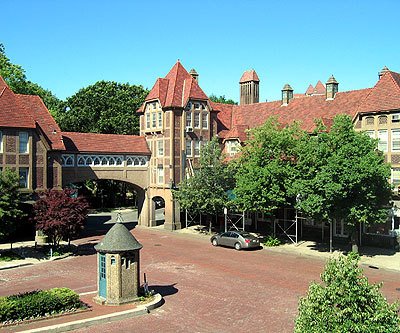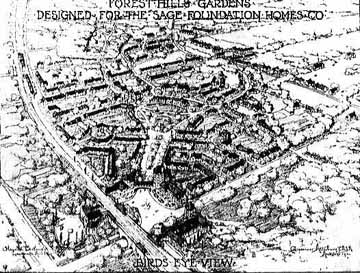Views
Forest Hills Home | Forest Hills History | Forest Hills: The Evolution | Current Community Profile | Education in Forest Hills | Unique to Forest Hills | What They Have to Say | What now?
I saw the sign - Ace of base
Contents |
A HISTORY OF FOREST HILLS
Colonial America
Forest Hills was a 600 acre plot of land originally called Whitepot when it was settled in 1652. Frederick Backus, George Backus and Horation N. Squires owned it, and in 1906, the Cord Meyer Development Company purchased the land. They renamed the area Forest Hills after its proximity to Forest Park. Architects Roger Tappan and William Patterson were hired to build up the neighborhood.
Forest Hills Gardens
Margaret Olivia Slocum Sage,the wife of Russell Sage bought a section land south of Queens Boulevard. Inspired by the book, "Garden Cities", she intended to create a development for working-class named Forest Hills Gardens. Frederick Law Olmstead, Jr. was the architect hired to develop these 142 acres of land for this model residential community. This plan turned out to be a short-lived plan because of the rising costs of land and construction details, which included expensive design elements on the houses such as terra-cotta-tiled sloping roofs. The Russell Sage Foundation added picturesque visuals to the nighborhood setting. This included period lamposts, winding cobblestone streets and lanes, a town square, and village greens[1] . Also, the Long Island Railroad had a stop at Station Square, acting as a gateway to Forest Hills Gardens. President Theodore Roosevelt gave a speech in support of America's involvement in World War I from this station [2].

Only a few blocks from the station was a graceful Tudor-style building that houses the West Side Tennis Club. It was not until 1923 that the stadium would open and become world-renowned[3]. Famous figures who lived in Forest Hills Gardens include Helen Keller; Dale Carnegie; John F. Hylan; entertainer Fred Stone; famed sculptor Adolph A. Weinman, and Geraldine Ferraro.
While it was originally known to be a rather exclusive neighborhood, Forest Hills is now considered very diverse, the 6,000 residents come from all over the world.
Northern Forest Hills
The Cord Meyer community is located in the northern area of Forest Hills and is characterized by single-family homes and low-rise apartment buildings. The award winning Cord Meyer Office Building is 10 stories tall and located on Queens Boulevard. Another prominent, yet modest building on Queens Boulevard is the Queens Windsor building[4]. Cord Meyer had operated a number of apartment buildings in Queens and was successful in converting all to Cooperative Apartment buildings. Soon into the twentieth century, Jewish immigrants began inhabiting the cooperative apartments. By the end of World War II, Forest Hills was populated primarily by middle-class Jewish and Italian residents. By the 1970s, the Bukharian Jews arrived in Forest Hills, impacting this area greatly[5]. The Bukharian Jewish community built what critics call "McMansions" and changed the profile of the neighborhood. They Bukharians explain, however, that the changes are necessary, as they must accommodate larger families[6] [7].
Forest Hills Co-operative Houses
Located in the northwestern area of Forest Hills, this housing project was extremely controversial. In the late 1960s, Mayor John V. Lindsay proposed to construct low-income housing in Forest Hills. The residents of Forest Hills protested this project and were embittered about the idea of bringing a significantly poorer population into the middle class neighborhood of Forest Hills[8]. As a compromise, the income requirements for the resident living in the housing project were made higher and the height of the buildings was decreased. Also created was the Forest Hills Community House, located on 62nd Drive[9] [10].
View Forest Hills Community House in a larger map
References
- ↑ Minton, Robert. Forest Hills : an illustrated history. Philadelphia: Lippincott, 1975.
- ↑ Copquin, Claudia. The Neighborhoods of Queens. New Haven: Yale UP, 2007.
- ↑ Minton, Robert. Forest Hills : an illustrated history. Philadelphia: Lippincott, 1975.
- ↑ Cuomo, Mario Matthew. Forest Hills Diary : the Crisis of Low-income Housing. New York: Random House, 1974.
- ↑ Vandam, Jeff. "LIVING IN/Forest Hills, Queens; A Newcomer Helps Push Up Prices." New York Times 21 Aug. 2005. 1 Apr. 2009 <http://query.nytimes.com/gst/fullpage.html?res=9805E6D6133EF932A1575BC0A9639C8B63&sec=&spon=&pagewanted=2>.
- ↑ Lakhman, Marina, and Dave Goldiner. "RUSSIAN JEWS: A RENEWAL OF FAITH RECENT IMMIGRANTS COME TO TERMS WITH RELIGIOUS FREEDOM." New York Daily News 11 Feb. 1999. 1 Apr. 2009 <http://www.nydailynews.com/archives/news/1999/02/01/1999-02-01_russian_jews__a_renewal_of_f.html>.
- ↑ "Cord Meyer." 29 Apr. 2009 <http://www.nyc.gov/html/dcp/html/cord_meyer/index.shtml>.
- ↑ Cuomo, Mario Matthew. Forest Hills Diary : the Crisis of Low-income Housing. New York: Random House, 1974.
- ↑ Papademetriou, Demetrios G. New immigrants to Brooklyn and Queens : policy implications, especially with regard to housing : a report of the Center for Migration Studies of New York, Inc.,. New York: Staten Island: The Center, 1983.
- ↑ "The Forest Hills Co-op, From Anger to Acceptance; The Forest Hills Co-... - Free Preview - The New York Times." Editorials and Opinion - The New York Times. 29 Apr. 2009 <http://select.nytimes.com/gst/abstract.html?res=FB0816F93E5F167493C3AB178FD85F428785F9>.


